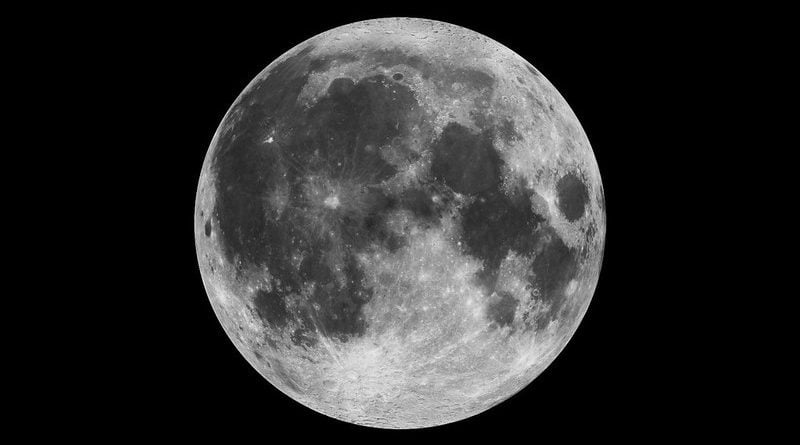Will Lunar Vertex solve the mystery of lunar swirls?
[ad_1]
The impact ideas
But where do lunar swirls come from? Blewett says there are three main hypotheses to explain the formation of lunar swirls.
The first two ideas posit external amplification of magnetic fields during impacts on the Moon, either from the gas and dust of a comet’s coma or the cloud of vapor and plasma generated by a large, basin-sized impact crater. Such large impacts throw up material, called ejecta, which, in the Moon’s low gravity, can travel vast distances and converge on the impact’s antipodal point on the opposite side of the Moon. During its journey, the material gets magnetized through “complicated means,” says Blewett.
Peter Schultz and Leonard Srnka proposed in a 1980 Nature paper that a comet between 650 and 1,640 feet (200 to 500 meters) in diameter — and possibly consisting of two nucleus fragments — hit the Moon, creating Reiner Gamma. They even found candidate impact sites for their proposed double impactor: Goddard A and the edge of the crater O’ Day. Goddard and its satellite craters are on the Moon’s eastern limb in Mare Marginis, while O’Day is on the farside. But if comets are responsible for this and other swirls, why aren’t there more of them? After all, as lunar researcher and author Charles Wood writes, “Various studies have shown that impacts from comets should be just as common as those from asteroids.” Additionally, one study failed to show spectral evidence at Reiner Gamma of materials usually associated with comets.
But if swirls are associated with impact eject from antipodal impacts, why isn’t Reiner Gamma antipodal to such an impact? One suggestion from Lon Hood at the University of Arizona’s Lunar and Planetary Laboratory and others is that Reiner Gamma may have formed from ejecta from the crater Cavalerius. But it might also be a consequence of the huge Mare Imbrium impact nearly 4 billion years ago, an idea that Hood supports. As it happens, Apollo impact breccias are the most magnetic of lunar samples, showing that impacts can induce magnetism.
Referencing a 2019 paper he co-authored in Journal of Geophysical Research: Planets, Hood suspects that most lunar magnetic anomalies were caused by iron-rich ejecta produced by the impactor that created the basin. For example, “the Imbrium basin is the youngest large basin on the near side of the Moon and many of the magnetic anomalies (including Reiner Gamma) are aligned radial to this basin,” he says. So instead of invoking an antipodal impact, his contention is that ejecta — now buried —deposited by the Imbrium explosion is the cause of Reiner Gamma’s mysterious white markings.
Hood also says that “the iron-enriched ejecta from Imbrium converged on the lunar farside at the antipode to produce the largest group of strong anomalies on the Moon. Similar concentrations of anomalies are found opposite to several other young lunar basins.” The pieces of ejecta would have been so big that they would have cooled slowly, “while they were being magnetized,” Hood adds. And any pre-existing magnetic field inside the Moon would have further magnetized the ejecta.
Hood says that Reiner Gamma “is perhaps the most enigmatic feature on the Moon and its origin will probably not be fully resolved for a long time.” That’s because, he says, the feature presents two separate problems: the origin of its magnetic anomaly and the origin of its light-colored curvilinear albedo markings. “The albedo markings are probably a secondary consequence of the magnetic anomaly,” Hood adds, “but exactly how … is a continuing mystery.”
But the Lunar Vertex mission will definitely help solve this enigma, he says.
Inside job
But there’s a third possibility for the Reiner Gamma magnetic field — and others like it — that doesn’t involve impacts at all. This idea is an endogenic, or internal, possibility, whereby lava cooled on or near the surface at a time when the Moon had its own global magnetic field. As the molten rock solidified, it preserved a record of the field even as the lunar interior cooled and the dynamo that generated the field died.
Douglas J. Hemingway and Sonia M. Tikoo suggested in 2018 that “heating associated with magmatic activity” within the Moon might have ramped up localized magnetic fields. “We suggest,” they wrote, “that these rocks were likely injected into the crust in the form of dikes and subsurface channels of flowing lava and that they cooled slowly, leading to enhancement of their metal content and enabling the rocks to capture a stable record of the Moon’s ancient global magnetic field.”
If the magnetic anomalies are endogenic, it raises questions about the volcanic and geochemical processes that produced rocks with high abundances of metallic iron, Blewett suggests. What’s more, nothing in the Apollo, Luna, or Chang’e sample collections have such compositions.
Whatever their cause, it seems that localized magnetic fields shield the surface from the normal space weathering that darkens the regolith in non-magnetic areas. It’s also possible that local electromagnetic effects cause the high albedo, or reflectance, of the swirl by prompting the movement of electrostatically charged dust over the swirls.
How strong are those fields? Blewett says, “We don’t actually know the strength of the local field down on the ground within one of the magnetic anomalies. That will be one of the major contributions of Lunar Vertex! However,” he adds, “it is unlikely that the fields are strong enough to protect the surface (or people or equipment) from dangerous high-energy radiation like cosmic rays or solar energetic particles.”
[ad_2]
Original Post


1,381 thoughts on “Will Lunar Vertex solve the mystery of lunar swirls?”